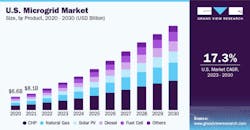Turn Down the Watts with Microgrids: The Decentralized Energy Network of the Future
Keeping pace with technological advances is just the beginning for Energy, Utilities, and Resources (EUR) organizations. They must now consider the survival of the planet and the people who live on it. The timeline to net zero is only getting shorter—so the hunt is on for new and innovative methods to improve sustainability.
Although an ever-shortening sustainability timeline puts immense pressure on organizations, it has accelerated the pace of innovation—delivering ideas and opportunities that were unheard of only a few short years ago. It’s given rise to the use of microgrids, miniature versions of the traditional grid, where power supply and distribution first began.The Current State of Play for Microgrids
In 2022, North America led the microgrid charge—accounting for more than 35% of the overall global microgrid revenue share, despite currently providing less than 0.3% of U.S. electricity.
There’s a long way to go, but microgrids have grown 11% in capacity in the last four years, and according to the Department of Energy, there are over 460 operational microgrids in the U.S. that provide 3.1 GW of reliable electricity to the communities they serve.
In the transition to a low-carbon economy, microgrids are now a highly attractive prospect with their ability to incorporate renewable energies and survive natural weather disasters, helping keep lights on, countries in power, and consumers unaffected.
The global microgrid market is now set to increase exponentially as more and more developing countries turn to microgrids to tackle crucial energy challenges. In 2022, the global microgrid market size was valued at $54.4 billion and is expected to grow at a compound annual growth rate (CAGR) of 16.3% from 2023 to 2030, with the U.S. projected to grow at a CAGR of 17.3%.
U.S. Microgrid Market Growth Projection. Image Source: Grand View Research
From reducing energy waste and system-wide blackouts to protecting workers and the environment they work within—microgrids have the potential to transform how the globe sources, distributes, and consumes energy.
Microgrids Spark a Sustainable Future
Given that microgrids are simply miniature versions of our existing, monolithic grid system—there’s much speculation on how they can be such a differentiator in the drive to sustainability. The answer boils down to the efficiency of decentralization and the energy mix used in microgrids.
A traditional grid—due to its consolidated design—is incredibly inefficient and results in a significant amount of energy wastage. By its very nature, moving electricity via transmission lines is not an efficient practice.
Take the U.S. for example. According to the EIA, in 2022, U.S. utility-scale electricity facilities generated 4.24 trillion kilowatt-hours (kWh). With a national average electricity rate of 23 cents per kWh, we’re throwing away over $48 billion in energy every year.
In comparison, microgrids generate and distribute energy locally. With no need to transmit over long distances, energy loss is mitigated, and its “backup capability” ensures that if the supply of energy is intermittent (for example, in cloudy or wind-free conditions), excess energy stored in batteries serves as an independent backup.
Additionally, microgrids work with all sources of energy. Along with more common options such as solar and wind, other sources such as hydrogen and tidal also support the model—so for sustainability reasons alone, it’s clear to see why more EUR organizations are turning to microgrid deployment.
Local Power Means Local Control to Prevent Future Blackouts
In part due to climate change, extreme weather conditions across the U.S. are becoming more common. Combined with an aging energy grid and increased demand, blackouts are part and parcel of living within the U.S. today.
The EIA estimates that, on average, U.S. electricity customers experienced just over eight hours of electric power interruptions in 2020. As a result, it’s given rise to increased occurrences of controversial preventative de-energizing – where the power of energy lines is shut off to prevent fires during high winds, for example – and reactive outages as a result of infrastructure damage.
Average duration of total annual electric power interruptions - U.S. Image Source: U.S. Energy Information Administration
The current issue stems from monolithic energy grids that have been built connectively. As the people of Texas discovered in the winter of 2021, when individual components fail, so does the grid.
In such circumstances, technology that is flexible, agile, and responsive will provide invaluable support—and it’s where microgrids, a composable system that allows systems to be assembled from smaller, independent components, will prove its worth in building resilience into the energy network.
Microgrids are independent of larger systems. Their ability to disconnect from the traditional grid and operate autonomously and locally ensures that if a microgrid fails, even if it is one of many microgrids feeding a larger model, the impact is limited to the local area of service.
Fail-safe and redundancy measures are easily implemented by building multiple microgrids to ensure continuous access to energy.
The ability to produce and store energy locally has taken off, with new use cases for microgrids on the rise. In Madera, California, the Valley Children’s Hospital is installing a microgrid system to provide continuous power in a region known for blackouts and grid failures due to wildfires and other extreme weather conditions. These early advances are just a precursor to the full potential of microgrids.
Improve Safety: Protecting Those That Make Microgrids Possible
The promise of microgrids to improve sustainability and reduce blackouts is clear to see—but the advantages of a decentralized grid still go one step further.
Traditional grids are vast. Transmission lines, which will need regular maintenance and infrastructure repair checks, regularly cover thousands of miles. Along with operating in a risky environment, the pressure is on the employees to travel long distances, often in remote locations, to do perilous work.
As inclement weather causes lines to fall, downed high-voltage conductors can often spark fires. As a result, worker injuries are common, and response times are usually delayed.
Here, microgrids provide the perfect solution as they do not distribute energy over long distances. Maintenance and repairs are carried out locally, while environmental conditions are managed in the moment.
How Microgrids Will Transform the Role of Utilities from Energy Providers to Service Providers
To make a decentralized grid a success, EUR companies will need to rethink their primary role within today’s society. In fact, EUR organizations will shift from their role as energy providers to become service providers.
As domain experts, EUR organizations must implement a more flexible business model where they trade on their expertise in energy production, storage, and distribution.
For some, these changes are already underway. For example, Green Mountain Power launched its Zero Outages Initiative, which seeks to boost system resiliency and lower costs to companies and consumers by implementing microgrid systems. These systems will ensure all Green Mountain Power customers in Vermont, whether urban or rural, will experience zero power outages by 2030.
Microgrids: The Next Big Step to a Sustainable Future
Microgrids herald an amazing step forward in how we power our planet and, ultimately, our lives, directly impacting the future of the EUR industry.
The change over to microgrids won’t be a quick fix, but the sustainability and availability benefits, alongside improved worker and environment safety, are worth the long-haul work to make microgrids a success.
Mark Your Calendar for the Microgrid 2024 Conference
April 22-24 in Baltimore: Join the Revolution in Energy
About the Author
Carol Johnston is a visionary in mobile workforce management technologies for the industry. For over 20 years she has successfully guided product marketing and product management for energy technology leaders including IFS, Clevest, ABB Software and Itron – identifying and developing emerging technologies to help energy organizations and utilities deliver safe and reliable services.
About the Author
Carol Johnston
Carol Johnston is Vice President of Industries, Energy, Utilities, and Resources, IFS.



